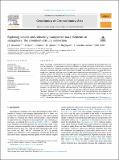Files in this item
Exploring soluble and colloidally transported trace elements in stalagmites : the strontium-yttrium connection
Item metadata
| dc.contributor.author | Sliwinski, JT. | |
| dc.contributor.author | Kost, O. | |
| dc.contributor.author | Endres, L. | |
| dc.contributor.author | Iglesias, M. | |
| dc.contributor.author | Haghipour, N. | |
| dc.contributor.author | González-Lemos, S. | |
| dc.contributor.author | Stoll, H.M. | |
| dc.date.accessioned | 2023-01-06T12:30:08Z | |
| dc.date.available | 2023-01-06T12:30:08Z | |
| dc.date.issued | 2023-02-15 | |
| dc.identifier | 282660396 | |
| dc.identifier | 0ae1a523-f360-4cef-b097-a86f9949c629 | |
| dc.identifier | 000923932000001 | |
| dc.identifier | 85145824218 | |
| dc.identifier.citation | Sliwinski , JT , Kost , O , Endres , L , Iglesias , M , Haghipour , N , González-Lemos , S & Stoll , H M 2023 , ' Exploring soluble and colloidally transported trace elements in stalagmites : the strontium-yttrium connection ' , Geochimica et Cosmochimica Acta , vol. 343 , pp. 64-83 . https://doi.org/10.1016/j.gca.2022.12.023 | en |
| dc.identifier.issn | 0016-7037 | |
| dc.identifier.other | RIS: urn:DE363A3475B257D0DB25C7D7823CF835 | |
| dc.identifier.other | ORCID: /0000-0003-3069-9978/work/125303032 | |
| dc.identifier.uri | https://hdl.handle.net/10023/26700 | |
| dc.description.abstract | While seasonality in speleothem trace element signatures is well-documented, the parameters that control the emergence of laminations vary between elements and tend to be multi-factorial. Here, we examine a series of active and fossil stalagmites from Asturias, Spain, with a particular focus on strontium and yttrium co-variations and fluorescent laminations. Coupled confocal fluorescence scanning light microscopy (layer counting) and time scales derived from accelerated mass spectrometry (F14C) in active stalagmites confirm that fluorescent banding is annual. This banding is coincident with Y peaks and Sr troughs, which are among the most robust trace element markers of seasonality. Strontium concentrations (in particular, the strontium partition coefficient, DSr) are positively correlated with stalagmite growth rate and are likely controlled by solution supersaturation, which is in turn controlled by seasonal variations in cave ventilation. DSr can be estimated after correcting for prior calcite precipitation using coeval Mg/Ca ratios, and is consistent with both empirical and experimental values. Meanwhile, yttrium is a proxy for colloidal organic input, and its concentration in stalagmites is likely controlled by a combination of Y drip water flux, surface retention time (i.e., how long a drip and its associated organic matter are in contact with the stalagmite surface), and dilation within the matrix (hereafter referred to as “dilation”). Persistent Sr-Y anti-correlation can be explained as an interplay between the individual controls on each element, and a breakdown in this relationship may be indicative of past changes in cave ventilation and/or drip hydrology. | |
| dc.format.extent | 20 | |
| dc.format.extent | 18686950 | |
| dc.language.iso | eng | |
| dc.relation.ispartof | Geochimica et Cosmochimica Acta | en |
| dc.subject | Speleothem | en |
| dc.subject | Stalagmite | en |
| dc.subject | LA-ICP-MS | en |
| dc.subject | Confocal laser scanning microscopy | en |
| dc.subject | Trace elements | en |
| dc.subject | Paleoclimate | en |
| dc.subject | Glacial termination | en |
| dc.subject | QE Geology | en |
| dc.subject | DAS | en |
| dc.subject | MCC | en |
| dc.subject.lcc | QE | en |
| dc.title | Exploring soluble and colloidally transported trace elements in stalagmites : the strontium-yttrium connection | en |
| dc.type | Journal article | en |
| dc.contributor.institution | University of St Andrews. School of Earth & Environmental Sciences | en |
| dc.identifier.doi | 10.1016/j.gca.2022.12.023 | |
| dc.description.status | Peer reviewed | en |
This item appears in the following Collection(s)
Items in the St Andrews Research Repository are protected by copyright, with all rights reserved, unless otherwise indicated.

